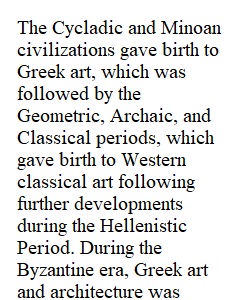


Q Read the discussion on Greek Art and Architecture (click links at bottom). Essay Prompt: The art of previous cultures (Mesopotamian, Minoan, Mycenaean, Egyptian) tended to focus primarily on the Afterlife, Religious or Funereal works, and Royalty with a sense of posterity in mind. Discuss the shift from this earlier focus and how Greek Art developed through the Classical Period. Cite and discuss specific examples to support your views? Approx. 500 words. Consider: You might discuss the shift to Greek Humanism (see definition below) and a focus on the "here and now" as opposed to the hereafter. Definition of Humanism: an outlook or system of thought attaching prime importance to human rather than divine or supernatural matters. Humanist beliefs stress the potential value and goodness of human beings, emphasize common human needs, and seek solely rational ways of solving human problems. Greek Architecture Link (Links to an external site.) Greek Art Link and sub-links (Links to an external site.) Virtual Tour of the Parthenon (Links to an external site.) Ancient Greece 3D tour
View Related Questions